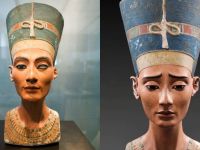Once a week, Om Ahmed prepares a dish of mallow greens with rabbit for her family of eight: her husband, Abdel-Maksoud, her elderly mother-in-law and her five children. This is the main source of animal protein in the family’s diet, which consists essentially of rice, bread, pasta, vegetables and beans.
Om Ahmed lives in a two-room house in the densely populated shanty settlement of Zawyet Abu Musallem, only three kilometres from the great pyramid of Cheops, on the outskirts of Cairo. On her husband’s meager salary, she has struggled to raise her children and put them through school.
“I want my children to have an education that will enable them to find good work,” she says, “which is why I was interested in joining Dr Hatim Abdel-Salaam’s rabbit breeding project. Thanks to this initiative, I have learned to look after the rabbits, which have multiplied many times over, and now I can sell some occasionally to supplement our family income.”
The project, launched with a grant of $10,000 from TeleFood, the Food and Agriculture Organization (FAO) of the United Nation (UN)’s campaign to raise awareness and funds to fight hunger, initially involved 20 families in Zawyet Abu Musallem. The primary objective was to transform participants into rabbit breeders and help low-income families achieve a measure of food security.
At the outset, the participants were provided with three female rabbits and one male, a two-level rabbit breeding battery, rabbit feed to last several months, medicines and vaccines. Abdel-Salaam, chief researcher at the Animal Production Research Institute of the Egyptian Ministry of Agriculture and the project coordinator, trained the participants in rabbit breeding and explained the use of vitamin and mineral supplements, and the administration of medicines for various conditions. The Ministry of Agriculture provided books and training manuals, but most of the participants are unable to read and must rely on their children to help them.
Now in its third year, the project has a high success rate -- 18 of the original 20 families have stuck with it and are making good progress. After reinvesting their earnings, some families now operate as many as six batteries housing several dozen rabbits.
An average female rabbit can start breeding at five months of age and produces around 30 offspring per year. Om Ahmed keeps only the females of each litter, selling the males at two months for 15-20 Egyptian pounds each.
With her earnings, Om Ahmed bought an additional rabbit breeding battery to house her growing rabbit population. She intends to enlarge the space allocated for them on her rooftop, where she also keeps hens and geese, and purchase another battery. “Some of our neighbors now have six rabbit batteries and are raising hundreds of rabbits, which they sell in the market,” she says. “My goal is to increase my sales, reinvest and enlarge my activity. In this way, I need not rely on my children’s work and can ensure that they remain in school.” — (menareport.com)
© 2003 Mena Report (www.menareport.com)







